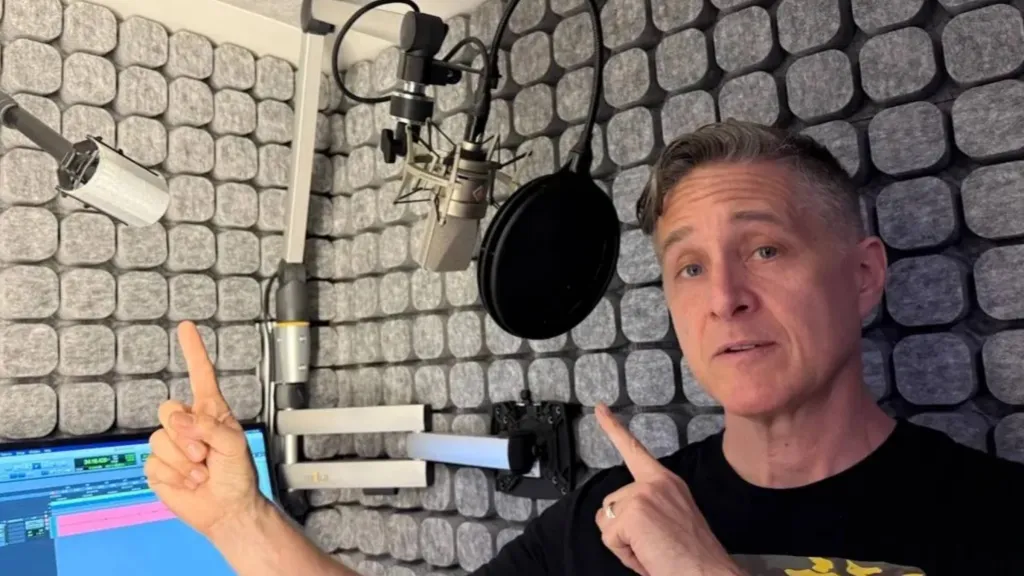Yuri Lowenthal and Tara Platt are sharing their experiences as voice actors with countless aspiring voice-over actors through Kajabi. Among the more prolific voice actors in the gaming and animation industries, Lowenthal and Platt have been active in the industry for years. There are hundreds of performances under their belts, giving them a unique perspective on the ways the industry has – and continues to – evolve.
Videos by ComicBook.com
That’s why they’ve been so keen to share that experience, even co-writing a book – Voice-Over Voice Actor – in 2010. They’ve wanted to take it to the next level for a while, but their busy schedules (and responsibilities as parents) have kept them from fulfilling that dream. Luckily, Kajabi gave them the perfect opportunity to construct a class that could fit their schedule while giving potential students around the world access to their lessons. During an interview with Comicbook.com, Yuri Lowenthal and Tara Platt discussed how they constructed the class, the keys to sustainable voice-over careers, and the importance of flexibility in the ever-changing industry.
Learning From Experience

Yuri Lowenthal and Tara Platt’s class will consist of multiple pre-recorded modules and come with various homework assignments to test the students in their mastery of the course. It won’t be a live course, which was very much by design. Reflecting on why now was the right time to move forward with the classes, Lowenthal and Platt noted that it’s not because their schedules have gotten any lighter. “If we waited for the time and the availability, it would never happen,” Lowenthal explained. Platt explained that they wrote Voice-Over Voice Actor 15 years ago because “So many people were asking us questions, and I had looked for a book to recommend, and there’s nothing that worked. So we wrote it ourselves, because that’s what we do. We updated it with the extended edition, and through this whole time, people have been like, ‘Can you teach? Will you teach? But we were like, we’re busy! We would hop into friends’ classes, one-off workshops.” However, finding the learning platform Kajabi was the key to the pair finally being able to move forward with their dream of a way to bring their collective experience in the industry to newcomers.
“They have lots of courses, and they have this ability to be self-led. It’s on your own schedule, at your own time. All of the education that we are trying to provide is pre-recorded.” There are over nine hours of video content in the class, spread out across 17 modules that break down into lessons, homework assignments, and videos. Platt noted that “We don’t have to all be available at 6:00 PM on a Tuesday, because that’s not going to work in our lives. We would be constantly rescheduling! We didn’t want to do that. We wanted to make it accessible for people on their own schedule, because other people might have lives that are as weird as ours.”
Deciding this was the ideal approach stemmed from a desire to empower people and allow them to do it at their own time. “If you’re a single Mom who is taking care of kids, but you’re interested in this, you can watch it when the kids are asleep. You have the freedom to do it on your own.” Citing their own experiences as parents, Lowenthal explained that “we’ve learned that the more you show trust and allow responsibility to present itself for people, the better they do.” “That’s true of all of us as humans,” Platt concurred.
“People are like, ‘I’m going to step up and I’m going to do the work for me, because I’m the one who benefits. If I don’t, I get the consequences.’ It’s like a college class. You get out of it what you put into it.” This also reflects a general change in the way that education is shared in the present day, with Lowenthal citing how remote situations are the norm in higher education. “Now, more than ever, things are available in a remote way. We thought that, if we can’t get everyone in the same location, then this is the next best thing.”
How To Sustain A Career In Voice-Acting

Both Lowenthal and Platt have been part of this industry for years, developing theory skills and honing their talents for an ever-changing world. Especially in voice-acting for animation and video games, where the technology always seems to be changing, there are hard-learned lessons and rewarding discoveries to be found in the perpetual growth of their craft. “As we move forward, the industry inevitably changes,” Lowthenal noted. “We get better and build on the experiences that we have had in the past. We got started out being interested in doing TV and film, and then we found voice-acting, and it opened up a whole new world.”
“I grew up watching cartoons and playing video games, but even after I got into the entertainment industry, I never looked at it like a job that people could get. That was eye-opening to me, and career-changing for both of us. Even that has changed in the time we’ve been doing it, because we started in theater, and then we went to TV and film, and then we found voice acting. Now, with the increase of performance capture and motion capture, hiring the same actor to do both the voice and the performance capture, which they didn’t use to do, has sort of brought us back around to theater again in a weird, full-circle sort of way. Now we get to play on a mo-cap stage with our entire bodies. It’s like being on a set or on a stage again. The full circle nature of it has been surprising, and it’s been something that we had to change and update as we began teaching.”
That’s just a reality of the evolving nature of the industry. Even just in the years since they wrote the book, the nature of voice acting has changed. Even beyond the technological advances, Platt noted that being in the booth and discovering dynamics with directors has morphed to meet the times. “When I first started, I wanted to be the best version of what I thought I needed to create. I thought that was really important. If you want to provide the goods, you show up as your best. Yes, that is important. But I have also discovered so much from mistakes. There’s a book called The Beautiful Oops, and I love that. It’s about saying, ‘Oh, I didn’t mean to do that, but now I can take that and I can use it.’ How can I take my flaws and have those become my features? How can this assist the growth process as an actor for the work I’m providing? I think being able to embrace more of the dark with the light, the more you can bring to the table, as opposed to just your polished stuff. Some of the unpolished stuff is just as interesting. That is one of the fun things I’ve discovered.”
To their minds, this is one of the true keys to success in the current voice-over landscape. “I think the opportunities in the industry right now lend themselves towards that type of thinking,” Platt said. “When you think about the types of games that are coming out, the types of shows people are consuming, it is less about the perfect idea of something and much more about a human, rough-edged, diverse approach. It’s emblematic of the work we’re doing.”
To illustrate her point, Platt explained how she’s currently working on being more open to her feedback and perspective on character. “There’s a lot more conversation about. People are like, ‘We wrote this, but let us know if that doesn’t align with how you envision this character, and then we’ll come to terms.’ Sometimes they’re like, ‘No, this character really does need to do that, because it supports the thing that is important that they’re bringing to the character.’ But sometimes, they say, ‘You’re right. They don’t need to say that.’ That’s where the character is coming from. It’s interesting, seeing how the work is changing… to be able to come to the table and do that, you need every tool in the toolbox. You need to know how to disassemble a script. I know how to make choices about my character. If what I think doesn’t resonate with the director or the producers, how do I make those changes so that then I can make sure we’re on the same page, that we’re playing in the same sandbox?”
That flexibility has helped ensure Lowenthal and Platt have enjoyed successful and wide-ranging careers as voice actors. There are hundreds of performances between the two of them, with the married couple even sharing space in some projects like Insomniac’s Spider-Man series. One of the most important elements to their enduring success in the field is “flexibility,” Platt explained. That ability and willingness to “dabble in all of the areas of voiceover” was key to their sustainability in the field. “Be less of a specialist. Don’t only do audiobook narration. Try to feel like you can do everything, get all the fingers in all the pies for voiceover, if that’s something you’re interested in. It’s melding and moving; there is more overlap. Sometimes you’ll have a video game character that goes on to be in an animated series. Things are always moving, so you want to feel like you understand the big picture.”
That also extends to the ways that AI has begun to impact the industry. Lowenthal, who became a leading voice in the 2024–2025 SAG-AFTRA video game strike, noted that his “knee-jerk reaction is fuck AI,” but that even he has had to come to terms with the fact that the technology is advancing and being implemented by the industry. “My short-term fear is that what they’ll try to do is use AI to replace people in the smaller jobs, NPC, and background characters. That’s how we both came up. You can’t always be the lead; there’s still so much to do in the background between big jobs. That’s how those jobs were, and we learned a lot from them. That’s some of the stuff we’ve put in the book and the class; I’m hoping the class will fill that need for people.”
“You can’t stop technology, nor should you be trying to stop it. Being flexible, like Tara said, and learning to work with things as they change, you actually learn more about it so that you can be more prepared for the change. We’ve talked to a lot of actors who have used the technology to forward their careers. They’ve used it in ways that don’t exploit them but empower them. I’m also a bit of an optimist when it comes to that. It’s changing now, and it will continue to change… It’s not the technology that’s bad; it’s the exploitative use of it. That can hurt people and not make the product better.” Platt concurred, noting that part of their flexibility as creatives in the voice-over space requires “using technology as a tool and using the artistry of the creatives—the creators, the actors, the writers, and the artists—all to make their own little Frankenstein monster together.” That’s where their digital course comes into play, using the advantages of modern technology to teach aspiring voice actors at their own pace.
Voice-Over Voice Actor: The Course is now available through Kajabi.








